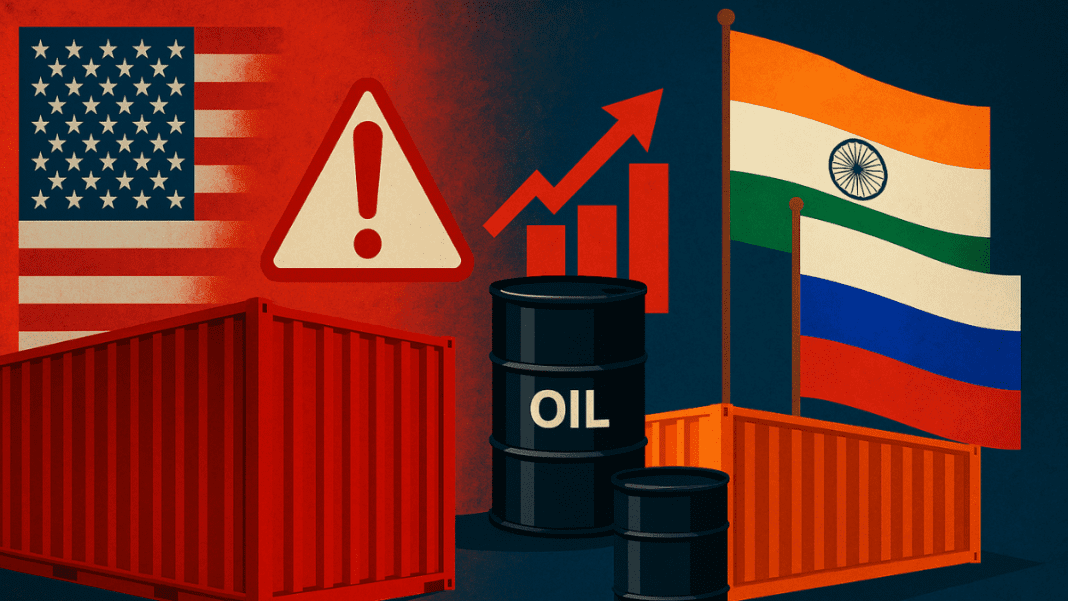US President Donald Trump has sparked a fresh international row by calling India and Russia “dead economies” in a fiery message posted online. His remarks come just as a 25% tariff on Indian goods is set to go into effect on August 1, putting growing strain on the US-India trade relationship. Trump’s criticism, focused on India’s close ties with Russia and high import taxes, has caused a sharp reaction in markets and led to warnings of a major export hit for New Delhi.
Trump’s Harsh Words Shake Trade Ties
In a post on his Truth Social platform, President Trump claimed that the US does “very little business” with India and accused the country of imposing some of the world’s highest tariffs. He wrote, “I don’t care what India does with Russia. They can take their dead economies down together, for all I care.”
The US and India, however, traded goods worth over $129 billion in 2024, making the US India’s largest trading partner. For the past few years, both countries have worked on building stronger cooperation in defense, technology, and regional security, mainly to counter the rise of China. But Trump’s aggressive tone suggests rising frustration in Washington, especially over India’s ties with Moscow.
The 25% tariff — just slightly lower than a rate Trump introduced in April — is due to be applied to a broad range of Indian products. However, official sources in New Delhi say they haven’t received a formal letter from Washington confirming the move. Trump has also said talks are still ongoing, adding: “We’ll see what happens.”
Rusophobe showdown — Russia accuses Italian president of Nazi comparisons in shock dossier
India’s Oil and Arms Deals With Russia in Spotlight
India remains one of the top buyers of Russian oil, second only to China. It also continues to depend heavily on Russia for defense supplies. Although Prime Minister Narendra Modi has taken steps to reduce reliance on Russian weapons by increasing purchases from the US, France, and Israel, India’s defense ties with Moscow remain strong.
Trump’s reaction appears to be partly driven by this continued relationship. He had warned earlier that countries buying weapons and energy from Russia could face economic penalties. His comments have drawn attention to the growing divide between US foreign policy goals and India’s strategic decisions.
India’s economy showed signs of concern. The Nifty 50 index fell 0.3% on Thursday, and the rupee dropped 0.3% against the US dollar before recovering. According to Indian financial analysts, the 25% tariff could reduce exports by as much as $10 billion, especially in sectors like textiles and engineering goods.
A major issue in the ongoing talks is India’s refusal to open its foodgrain and dairy markets to the US. The Modi government has stood firm, saying those markets support hundreds of millions of people and are too important to expose to foreign competition.
🚀 Russia’s R-77M missile makes combat debut—Ukraine’s skies turn deadly
Trump Mentions Pakistan Oil Deal, Upsets India Further
To make matters more tense, President Trump also mentioned a new energy partnership with Pakistan. He said the US would help Pakistan develop its large oil reserves and added: “Maybe they’ll be selling oil to India someday.” Many saw the remark as a move to provoke India, especially after recent border clashes between the two countries.
Trump’s reference to Pakistan has not gone over well in India, where public sentiment is already uneasy due to the growing trade pressure and the mention of India’s economy as “dead.” The move adds another layer to the already complex situation between Washington and New Delhi.
One area that remains untouched by the tariffs is India’s smartphone exports, especially iPhones assembled in India. These have become a major part of India’s exports to the US. Apple and other tech firms have moved a significant portion of their manufacturing from China to India in recent years.
The tariffs do not affect electronics and pharmaceutical exports for now. But the stand-off raises concerns. These goods may become targets later.

